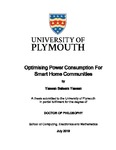Optimising Power Consumption For Smart Home Communities
| dc.contributor.supervisor | Ghita, Bogdan | |
| dc.contributor.author | Yaseen, Yaseen Saleem | |
| dc.contributor.other | School of Engineering, Computing, and Mathematics | en_US |
| dc.date.accessioned | 2019-09-30T14:27:48Z | |
| dc.date.issued | 2019 | |
| dc.date.issued | 2019 | |
| dc.identifier | 10518843 | en_US |
| dc.identifier.uri | http://hdl.handle.net/10026.1/14950 | |
| dc.description.abstract |
Households’ demand-side energy management systems are considered as primary units for optimising power consumption in a community-based environment by peak load minimisation. These peak periods are expensive for energy providers and consumers. The power management in one community can reduce power consumption fluctuations and improve the response to power price variations per day. The fluctuation demand is not convenient in terms of planning, expenses, and logistics. Therefore, more stable demand will allow suppliers to use cheaper resources and avoid the need for additional resources, which are normally used to meet the load demand at peak times. In the current literature, the focus is on reviewing the shortcoming of methods that address load demand stability. This load demand stability is usually measured by the peak-to-average ratio (PAR) of the households’ load demand. Therefore, the best PAR is when the peak doesn’t go beyond average by minimise PAR values and is as close as possible to one. However, there is a notable absence of empirical research investigating aspects joining community-based solutions, appliance-by-appliance analysis, and using real-load profiles in energy management systems. In addition, beyond proposing new energy management systems, prior research assumed users are willing to allow an automatic system to control their power usage unconditionally. This assumption may not hold for a typical environment. Third, suboptimal scheduling patterns to reduce the PAR are obtained using algorithm-based energy management systems. These patterns depend on how the data load profile is structurally parsed; however, using a mathematical model gives the optimal scheduling pattern solution. In this context, this project aims to reduce these fluctuations to the degree that the demand for energy would be more constant in a 24-hour cycle and closer to the ideal scenario. This will benefit the utility providers, households, and the environment. First, a novel demand-side management (DSM) stage is proposed to optimise power consumption patterns of R-users in individual and community-based scenarios. This new DSM focuses on a community-based allocation of power demand for minimising the peak load. Utilising the decisions made by the proposed DSM, single R-users minimise the PAR of the power system by shifting consumption to off-peak times individually. However, it is more effective when the policy is applied in the community-based nature of the demand and allocation is considered. This intuition is supported by the empirical results. Second, a novel energy management stage within an energy management system (EMS) is proposed to optimise power consumption and to reduce the overall PAR for a community of R-users. This new stage is merged as a new component to the first novel DSM stage. The above two proposed systems were evaluated on a set of 15 R-users’ load profiles, using randomly assigned willingness values, by measuring the load of each individual R-user profile during a 24-hour cycle with a 10-minute resolution. The results show the suggested algorithm provides an average PAR reduction, which is 12.37% for the single R-user scenario and 22.66% for the multi-R-user scenario. The addition of willingness reduces the benefits’ reach to 10.34% for the single R-user scenario and 16.25% for the multi- R-user considering their willingness. Third, a novel energy management stage for PAR minimisation, based on a mixed-integer nonlinear programming (MINLP) mathematical model is proposed. MINLP is formulated to minimise the PAR in single and community-based scenarios through providing orders, which include the optimal scheduling power usage patterns of shiftable appliances during a day with a 10-minute resolution. The measurements show the proposed framework’s effectiveness, which provides a significant PAR reduction up to 50% in the community-based scenario. | en_US |
| dc.description.sponsorship | The Higher Committee for Education Development in Iraq (HCED) and University of Anbar / Renewable Energy Research Center, University of Anbar, Ramadi, Iraq | en_US |
| dc.language.iso | en | |
| dc.publisher | University of Plymouth | |
| dc.subject | Load scheduling | |
| dc.subject | Peak-to-average ratio | |
| dc.subject | Energy consumption scheduling | |
| dc.subject | Demand-side Management | en_US |
| dc.subject.classification | PhD | en_US |
| dc.title | Optimising Power Consumption For Smart Home Communities | en_US |
| dc.type | Thesis | |
| plymouth.version | publishable | en_US |
| dc.identifier.doi | http://dx.doi.org/10.24382/445 | |
| dc.rights.embargodate | 2020-09-30T14:27:48Z | |
| dc.rights.embargoperiod | 12 months | en_US |
| dc.type.qualification | Doctorate | en_US |
| rioxxterms.version | NA |
Files in this item
This item appears in the following Collection(s)
-
01 Research Theses Main Collection
Research Theses Main


